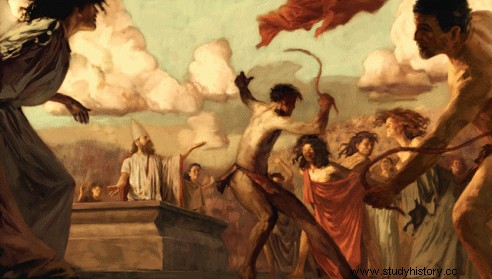Paper hearts with intimate confessions, plush mascots, holding hands and chocolates? Not at all. Ancient lupercalia (or pagan valentines) looked more like debauched fertility festivals, and the Romans showed love in a very unprudent way. At the same time, they did not lack creativity…
Although it is commonly believed that Valentine's Day is celebrated in mid-February to celebrate the tragic death of St. Valentine (by the way - the patron saint of not only those in love, but also the mentally ill and epileptics), the roots of the holiday of love need to be looked for much deeper. One theory is that they were "invented" by the ancient Romans many centuries before the execution of the Catholic martyr, which took place around 269-270.

The Faun cult played a significant role during the Lupercalia.
According to this hypothesis, today's day of lovers would be only a Christianized version of the old pagan celebration. But are you sure? Current customs are very different from those of antiquity. So how did the ancient Romans enjoy "their" Valentine's Day?
Whipping for sterility
The discrepancy already appears in terms of the date. The day of celebrating this (there was no joyful) holiday in antiquity fell on February 15, not 14. It was not a random date - around the middle of the month, Roman birds began to look for partners for the coming spring. However, it was not only the surrounding nature that gave the ancient inhabitants of the empire an excuse to celebrate. Adam Węgłowski describes:
The Romans mentioned that day, among others, the "she-wolf" Akka Larencja, who, according to legend, not only fed Romulus and Remus, but also looked after Faun.
On the days of lupercalia, the half-naked priests of this weirdo ran around the streets threatening men with knives and whipping women at them. Their impact was not so much painful as it was happy - it was supposed to heal women from infertility.
How was flogging conducive to increasing birth rate? It's hard to say, but the Roman women readily submitted to it - the childless ones believed that thanks to this they would soon have children, the pregnant women wanted to guarantee an easy and safe birth, and the virgins symbolically entered adulthood.

During the festival, women were flogged with thongs to guarantee fertility.
So where did the later date shift come from? Well, the ancient Valentine's Day celebrations were also initiated on the 14th day of the month - supposedly then a love lottery was organized in the Eternal City, during which the boys drew scraps of paper with the names of the girls from the urn. In this way, the young people were selected in pairs for the proper celebration (it sometimes happened that they stayed with each other for longer - at least until the next lupercalia).
Offerings to the god of debauchery
According to tradition, the ancient feast of lovers was established by a mysterious Greek visitor, Evander, the legendary founder of the cult of Hercules in Rome, and the entire festival was under the patronage of a Faun bearing the nickname Lupercus, that is, Protecting Against Wolves (apart from the fertility of women, Valentine's rituals were also supposed to ensure the prosperity of cattle breeders - by increasing the number and ensuring the safety of the herds against attacks by predators).
The celebration began at the Lupercal Grotto on the western slope of the Palatine Hill - the same one where the she-wolf would feed Romulus and Remus. Twelve priests, called luperki ("wolf brothers"), performed a bloody rite there. First, two goats and a dog were solemnly slaughtered, and then the foreheads of two young men were smeared with the blood of the animals. At the end, the stains were rubbed with wool soaked in milk to symbolize cleansing.

"Faun"
At the same time, this gesture was a signal to move to the next point of entertainment. Men exposed themselves, and then naked or dressed only in blood-dripping skins of freshly killed goats circled the Palatine Hill, laughing loudly and lashing the onlookers with their thongs. It was believed that such a spanking, although probably not very pleasant, cleanses a person of all blemishes and faults of the past year and replenishes the life and creative forces in the body.
Lupercalia gathered crowds each time. Even the advent of Christianity did not harm their popularity. And while there were those who tried to forbid the vile, pagan practices completely, they failed miserably.
In the end, the Church decided to "civilize" the fertility celebration. The Valentine's Day was therefore associated with the Feast of the Purification of the Mother of God (now the Feast of the Presentation of the Lord). Even later, Valentine's Day won its today's patron, who, on the eve of the execution on February 14, was to send a letter to his beloved with the well-known phrase:"From your Valentine".
Bibliography:
- A. Gillmeister, D. Musiał, In the Shadow of the Capitol. Religion of the Ancient Romans, "Historia Iagellonica" Publishing Society 2012.
- M. Jaczynowska, Religions of the Roman World, PWN 1987.
- Dictionary of ancient culture, ed. R. Kulesza, Publishing House of the University of Warsaw 2012.
- A. Węgłowski, Centuries of Shamelessness. Sex and erotica in antiquity, CiekawostkiHistoryczne.pl 2018.
